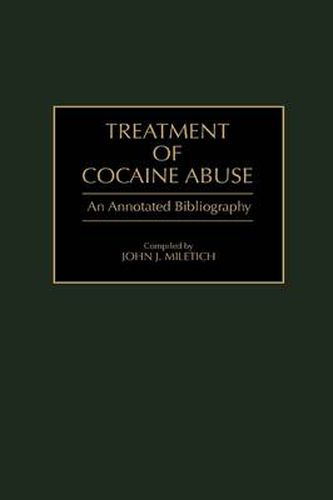Readings Newsletter
Become a Readings Member to make your shopping experience even easier.
Sign in or sign up for free!
You’re not far away from qualifying for FREE standard shipping within Australia
You’ve qualified for FREE standard shipping within Australia
The cart is loading…






Cocaine has been a socio-medical problem for centuries. In the United States, the first cocaine epidemic occurred between 1880 and the 1920s. In the 1960s shortages of heroin as well as government programs to stop the smuggling of marijuana may have stimulated the use of cocaine as a substitute. With the development of crack, cocaine became available at a price that make it accessible to virtually anyone. Today, the long-term effects of crack are just beginning to be felt, especially among children born of users. Treatment of cocaine abuse has traditionally been non-pharmacological, although beginning with the 1980s, various drugs have been used to decrease cocaine craving. This bibliography contains more than 600 references, spanning a century of research and writing. Source publications, all of which are annotated, include books, articles, conference proceedings, dissertations and government publications. The material is organized within four subject-oriented chapters and alphabetically within each chapter. Author and subject indexes provide additional access. In addition, Miletich includes appendixes on common names for cocaine, videocassettes about the drug and a timeline. The work will be of value to researchers as well as social workers, psychologists and others working in the substance abuse field.
$9.00 standard shipping within Australia
FREE standard shipping within Australia for orders over $100.00
Express & International shipping calculated at checkout
Cocaine has been a socio-medical problem for centuries. In the United States, the first cocaine epidemic occurred between 1880 and the 1920s. In the 1960s shortages of heroin as well as government programs to stop the smuggling of marijuana may have stimulated the use of cocaine as a substitute. With the development of crack, cocaine became available at a price that make it accessible to virtually anyone. Today, the long-term effects of crack are just beginning to be felt, especially among children born of users. Treatment of cocaine abuse has traditionally been non-pharmacological, although beginning with the 1980s, various drugs have been used to decrease cocaine craving. This bibliography contains more than 600 references, spanning a century of research and writing. Source publications, all of which are annotated, include books, articles, conference proceedings, dissertations and government publications. The material is organized within four subject-oriented chapters and alphabetically within each chapter. Author and subject indexes provide additional access. In addition, Miletich includes appendixes on common names for cocaine, videocassettes about the drug and a timeline. The work will be of value to researchers as well as social workers, psychologists and others working in the substance abuse field.